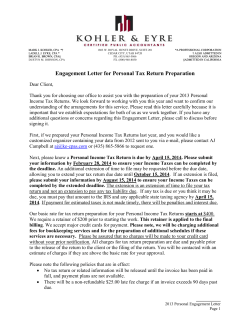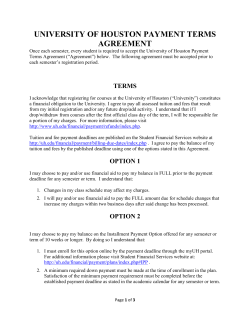
Understanding Electricity Transmission and Distribution Charges and How to Reduce Them Feature
Feature Understanding Electricity Transmission and Distribution Charges and How to Reduce Them By Ritchie Priddy and Lily Le, GDF SUEZ Energy Resources I n 2002, the retail electricity industry was deregulated for most utility service territories in Texas.1 Since then, energy consumers in the deregulated territories have been able to negotiate the supply component of electricity service from a Retail Electricity Provider (REP) offering supply service in competition with other REPs. While consumers have been able to negotiate their energy supply rates through the benefits of competition, many are still unclear of the role their local utility, or “Transportation and Distribution Service Provider” (TDSP) plays, and the costs associated with such services. The Texas Public Utility Commission (PUC) continues to regulate TDSPs by setting the rates for transmission and distribution service. The TDSP is responsible for operating and maintaining the poles, wires, and meters that provide the electricity consumed by homes, schools and businesses. They also are responsible for restoring service when there is a power outage and reading your meter on a routine basis. Regardless of which REP you choose to provide the supply component of your service, the delivery of the electricity is still provided by your local TDSP. 14 TASBO Report • December 2009 The charges assessed by the TDSP are largely based on a kilowatt (kW) unit and characterized on your bill as “demand” charges, while the supply costs charged by your REP are based on a kilowatt hours (kWH) unit of consumption. Fully understanding the TDSP charges may provide you with ideas on how to reduce them. Demand Based TDSP Charges Demand is a measure of electric load over a given period. Your TDSP is required to have reliable electricity service available to meet customer needs, whenever you need it, even if all of it is needed at the same time. In other words, the TDSP must be prepared to provide electricity whenever customers “demand” it. As such, Texas non-residential customers with demands greater than 10 kW are billed a demand charge. Measured in kilowatts (kW), the amount of the demand charge is established by the highest 15-minute consumption period during the month. Each TDSP also levies what is commonly referred to as a “ratchet” charge that is associated with the demand charge. More on that later. High levels of demand are usually associated with equipment such as motors, HVAC, lighting and receptacle loads such as floor heaters, computers, etc. A good analogy to how your demand level, and consequently your demand charges from your TDSP, is established is your car’s engine. An automobile engine has a capability to propel you down the road at some maximum speed, based on its horsepower, the weight of the car, and how the engine is tuned to run. Likewise, your demand charge is established based on the maximum amount of electricity you are capable of consuming in a 15 minute period, or said another way, based on how much you were “demanding” off the grid at one time. The meter (much like a speedometer) records how much power (kW and kWH) was used during that 15-minute period and the customer is then billed on that usage factor regardless of whether they ever “demand” that much electricity from the grid again. Another way to look at demand charges is as if you were paying a perpetual rent on an apartment. You never own the apartment, but are paying for it as long as it exists. Regardless if you use the apartment one night or 30 nights a month, you are still required to pay the entire rent. For instance, if your facility has a maximum peak load of 1,500 kW, but only Feature reaches that level once a year, the utility is required by the PUC to construct and maintain the necessary infrastructure to serve your facility as if you were using that much power all the time. That capability of demanding electricity establishes your demand charge. Most TDSP tariffs bill at either the highest actual peak demand or 80% of the annual peak demand set in the previous 11 months. This is the ratchet charge and is illustrated in the table on the previous page. The Texas PUC has standardized all five of the deregulated TDSP territory tariffs so, they are essentially identical. In the table on the previous page, notice that the customer is billed from January – May based on the billing demand of 507 kW, despite reaching an actual demand of only 469 kW. That is because in the previous 11 months, this facility recorded its highest peak demand of 634 kW (September). The tariff allows the utility to bill for 80% of the high demand, hence 507 kW. In June, the actual kW jumped up to 615 kW; hence, the billing kW for that month increased to 615 kW and remains there (or 80% of the annual peak high) until a higher demand is set in a subsequent month. There are many ways that consumers can reduce their demand-based TDSP charges such as staggering high consumption rate equipment (so it’s not all consuming electricity at the same time). Preventative maintenance practices and larger scale efficiency projects (such as lighting, HVAC replacement, etc.) can also help keep costs lower. If your facility is eligible, participation in state or TDSP-sponsored efficiency programs or demand response programs is another means to reduce the overall cost of your TDSP and electricity supply bill. Poor Power Factor Increases Demand Costs Another TDSP charge that consumers need to be aware of is the penalty TDSPs charge customers for the inefficient use of power. Power use efficiency is measured by “power factor.” Power factor is a measure of how efficiently, or inefficiently, that electrical power is used by a customer. Power factor is associated with demand and some TDSPs bill customers for power factors below .95 (95%). The operating power from the distribution system is made up of both active and reactive elements. A simple way to look at power factor is to think of it in terms of a glass of beer. You want as much beer as you can in the glass with as little foam as possible. Foam Beer Working and Non-Working Power Example: As a customer’s power factor drops, the system becomes less efficient. A drop from 1.0 to 0.9 results in 15% more current being required for the same load. A power factor of 0.5 requires approximately 100% (twice as much) to handle the same load. The answer to these problems is to reduce the reactive power drawn from the supply by improving the power factor.2 Penalties for poor power factors can add up to several thousand dollars per year in added costs to the customer. Customers can correct a poor power factor by installing capacitors, and while this can be costly, the savings can be impressive. Additional potential benefits for correcting poor power factors include longer equipment life, stabilized voltage levels, and increased capacity of your existing equipment. Usage Based TDSP Charges The kWH charges levied by your TDSP are not based on demand, but rather like your electricity supply charges, are based kW Demand (How fast) kWH (How far) on the actual quantity of electricity (or commodity) you use or consume. Using our analogy above, the kWH charge is similar to a car’s odometer. It tells you how far you’ve travelled or how much energy you used in one month. Charges on your TDSP bill applied to consumption include the System Benefit Charge, of up to $0.00065/kWh, which funds low income energy assistance and energy efficiency.3 Additionally, Texas requires that TDSP companies meet 20 percent of their load growth by December, 2009 through energy efficiency. Each company is assured of rate recovery for “reasonable costs of providing energy efficiency programs.”4 These energy efficiency charges also appear on the TDSP portion of your energy bill and are based on consumption. Energy conservation and efficiency improvements are the most effective ways to reduce your usage related charges. Low cost or no cost state mandated efficiency programs may provide solutions to lowering your energy bills. Additionally, many REP’s partner with selected companies to provide more in-depth efficiency and conservation services. Consumers who are interested in learning more about state-mandated TDSP energy efficiency programs may go to the following links: Oncor: www.oncor.com/electricity/ teem/default.aspx CenterPoint: www.centerpointeefficiency.com AEP: https://www.aeptexas. com/save/learn/Default.aspx Continued on page 16 www.tasbo.org 15 Feature Transmission and Distribution, continued from page 15 Ritchie Priddy is Director, Sustainability Marketing for GDF SUEZ Energy Resources NA. Lily Le is Regional Sales Manager, Education for GDF SUEZ Energy Resources NA. 1 The TDSP service areas in Texas open to retail electricity competition are Oncor, Texas New Mexico Power, CenterPoint, AEP South and AEP North. Understanding Power Factor: A Layman’s Guide, http://www.pqmanagement.co.uk/PFC%20Basics%flyer.pdf 2 3 http://www.puc.state.tx.us/rules/ subrules/electric/25.451/25.451.pdf http://www.puc.state.tx.us/rules/ subrules/electric/25.181/25.181.pdf 4 Electricity Pricing, continued from page 13 When comparing electricity prices, make sure the suppliers are offering “like” bandwidth and Add/Delete allowances to get a true apples-toapples price comparison. Suppliers may also differ on the number of allowance percentage options offered. For example, some suppliers may offer only one allowance percentage, while others may offer several options. Suppliers may also differ in other benefits offered, such as pool incentives, pre-pay or early-pay rate discounts, cost avoidance opportunities, and customer service differences, which should be considered when determining the overall “best value” for a school district. In summary, when school districts are seeking new electricity contracts, they should identify how much electricity price risk they can reasonably accept. The more risk that is placed on the supplier, the higher the district’s cost for electricity. It is also important to choose suppliers that are credit-worthy counterparties, with a good track record, that the districts can count on to stay in business for the duration of the contract. 16 TASBO Report • December 2009
© Copyright 2025










